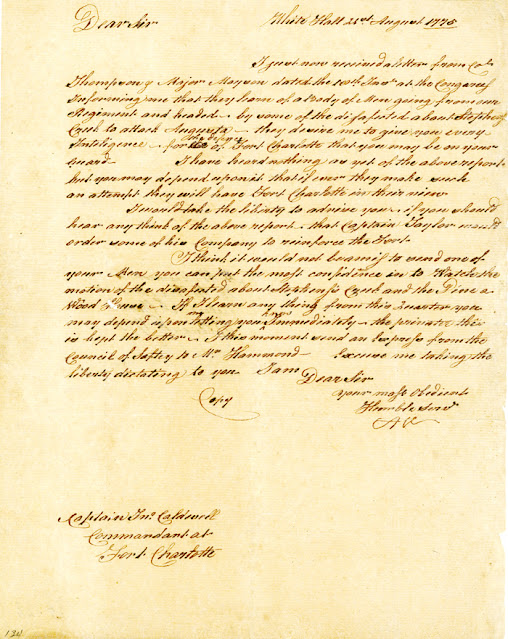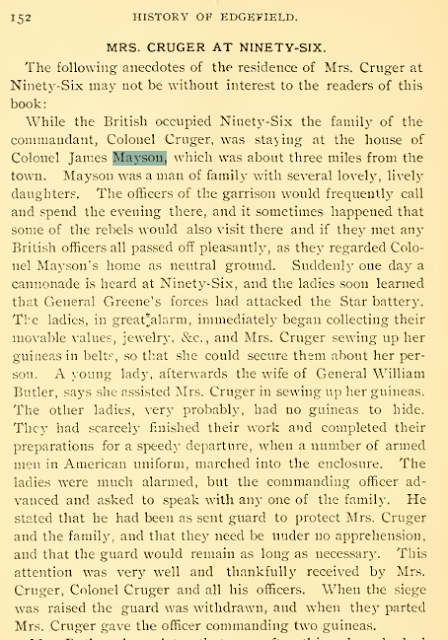(Note: This page is a work in progress)
Here are a few select records that I found for James and his probable sons during the American Revolution. Most of these are for James, Sr. but one of them might be for his son James, Jr.
July 1779 payroll of the officers of the 3rd SC Regiment of South Carolina
Lt. Colonel James Mayson and his father-in-law, Rev. Samuel Hart, Chaplain
(Familysearch.org)
Lt. Colonel James Mayson and his father-in-law, Rev. Samuel Hart, Chaplain
(Familysearch.org)
This 1781 document is confusing: The signature appears to be John Mayson but the document is filed under James Mayson. The original document needs to be examined.
(SC Archives)
Record from 1786 for a horse lost. I am not certain that this is James Sr. - it could be his son James Jr.
(SC Archives)
1787 Pay Voucher, Lt. Col. James Mayson, 3rd SC Regiment
(SC Archives)
August 1775 Letter from Andrew Williamson to Captain John Caldwell noting receipt of a letter from Col. (William) Thomson and Major (James) Mayson with details about a possible threat to Fort Charlotte.
(SC Archives)
-----------------------------------
Orders from Rev. William Tennent III (Council of Safety) to Captain John Caldwell at Fort Charlotte.
(SC Archives)
Rev. Tennent was a famous Presbyterian Minister who was deeply involved in the Revolutionary War effort. He was the grandson of Rev. William Tennent, the founder of the first Presbyterian seminary in the colonies (Log Cabin School) which was likely the precursor to Princeton University. See more here: >>Rev. Tennent III<< and >>William Tennent << and >>Princeton history<<. and >>Plaque<<
-----------------------------------
November 1775 document outlining a "Cessation of Arms" between Major Joseph Robinson of the "Body of Her Majesty's Militia" and Major Andrew Williamson & Major James Mayson Commanders of the Fort at Ninety Six under the direction of the Provincial Congress. Among the signatures are notables Andrew Cunningham, Andrew Pickens, Joseph Robinson and James Mayson.
(SC Archives)
----------------------------
A November 1775 account of activities written by Andrew Williamson to William Henry Drayton. The document is very hard to read but James Mayson is noted several times and Andrew Williamson even notes that a small disagreement arose between himself and James Mayson regarding command of the militia.
(SC Archives)
----------------------
Lt. Col. Cruger and his wife "stayed" at James Mayson's home during the 2nd Siege of Ninety Six in 1781
History of Edgefield County, John A. Chapman, A.M., pg.152
Lt. Col. Cruger's wife and James Mayson's home during the 2nd Siege of Ninety Six
Ninety Six, A Historical Narrative, Jerome Greene, National Park Service, 1978 (not copyrighted)
This is Lt. Col. John Harris Cruger, a leader of the British Army, and chief designer of Star Fort.
Was James Mayson friendly with the British at this point? Or was he forced to accommodate the enemy in his home? Had he been captured and "paroled" and somewhat forced into this role? This appears to be 1781 when Gen. Greene re-took Ninety Six from the British. Or, was this story simply just another anecdote with no factual basis? It is hard to separate the societal bonds that existed between the gentry classes especially when considering the etiquette that was strictly maintained among the political and military leaders. Much like the courtesies that existed between General Robert E. Lee and his Union opponents during the American Civil War, there may have been unstated rules of behavior between "gentlemen". If Mayson was paroled and accepted this status, he would have remained neutral and he could hardly refuse to accommodate the British officers - especially to save his family and property. The loyalties that existed during this time were often quite "fluid".
(This page was created on 8/11/2023)

.jpg)






.jpg)
.jpg)




